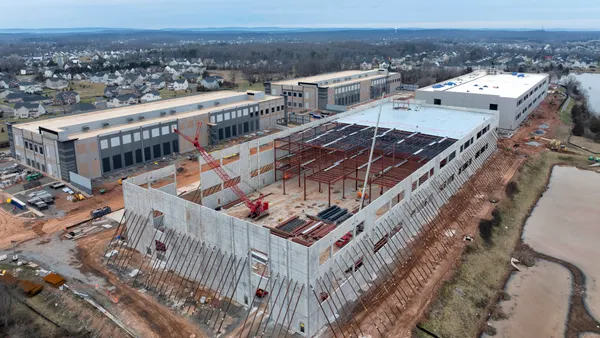Summer often marks the apex of activity on construction jobsites. With longer days and warmer weather, there’s ample opportunity to knock out a project’s punch list.
The same is true of beehives. Higher temperatures are ideal for bees to collect nectar and pollen from plants while making honey that will help build food stores and carry them through the colder winter months.
For Peter Murawski and Patrick Haddigan, two superintendents for New York City-based Turner Construction who are also avid beekeepers, that’s just the beginning of the similarities between working in construction and tending to bees and beehives.
Starting at the bottom
Take a project’s foundation, for instance. “Nothing good and lasting can be built on a poor foundation,” said Murawski, a fourth-generation beekeeper who learned the craft from his grandfathers, uncle and father and has worked in the Boston area for Turner since 2013.

Murawski said the same is true for apiaries, the bee boxes where hives are kept.
“Your foundation has to be set properly in a dry and mostly sunny location,” Murawski said. “You’ve got to set the baseboard with a slight slide to allow rainwater to drain so water doesn’t flood the hive inside.”
Beyond those types of physical similarities, though, Haddigan noted there’s a tie-in between the reasons behind why one does construction work, as well as why someone would go into beekeeping.
“A good beekeeper is someone who really cares about the bees as a whole,” said Haddigan, who said he finally “caved” into beekeeping after listening to Murawski tell story after story about his hobby as they worked on projects together. “Don’t get into beekeeping if you just want the honey. That’s not the reason to do it.”
Likewise, while opportunities in construction are plentiful, with a severe shortage of workers pushing salaries as much as 20% higher since 2021, Haddigan says that can’t be the only reason to go into this business.
“You have to care about what you’re doing to really turn out a good product,” said Haddigan, who’s worked in construction for more than 26 years, the last 13 at Turner. “In both worlds, the only way to succeed is to work hard and pay attention to the details along the way.”
Listen to your workers
Another similarity both of these construction pros called out was the need to pay attention to what’s happening on the jobsite, and in the apiary, on a day-to-day basis, while listening to what your workers — and bees — are telling you.

“Bees show you and teach you how to be persistent and organized,” said Murawski. “They will also tell you when they are not happy and where you need to improve.”
The same is true on a complex construction project, he said. “Just like bees communicate in various ways with other bees, including drones from other colonies who are following a hierarchy of orders, a superintendent has to be able to find ways to communicate with the design team, clients and most importantly, our subcontractors.”
Every role has value
He also makes a comparison between the worker bees inside a hive. Bee carpenters, for example, plug up any unwanted drafts and build new wax combs where food and honey can be stored. All the while, the queen meticulously monitors temperatures inside the hive and delegates workers to ventilate the structure, both inside and out, by flying and flapping their wings.
At the same time, the queen is directing her worker bees to fly out, evaluate the area and collect pollen and nectar. And just like workers on site might give each other tips of what’s working — or not — on a particular project, Murawski said bees tell each other where the best resources are in a given area.
“It’s the same thing with being a superintendent on the jobsite,” Murawski said “We should always have a Plan A and Plan B, and if one recourse doesn’t work, we need to communicate it to others. That’s how you assure success.”
Communicate for the win
That theme of communicating up and down the chain of command at a construction site, and within a bee colony, resonates with Haddigan as well.
“One of the biggest factors to being a good beekeeper is you need to listen to your bees — they will tell you when they are hungry or need more space in the hive,” Haddigan said. “The same is true on the jobsite: you need to listen to all parties, from the workers in the field to the architects, engineers and clients. Caring for the site and workers will always pay dividends.”
For both builders, troubleshooting and paying attention to detail — both at work and in the beehive — has been a labor of love.
“The similarities are truly amazing,” Haddigan said. “Listening to your audience is rule No. 1.”




















